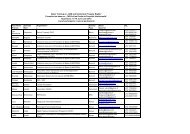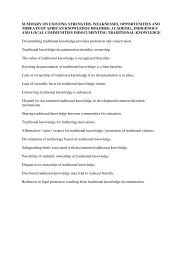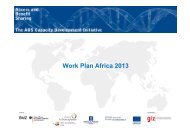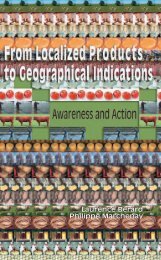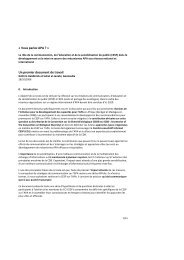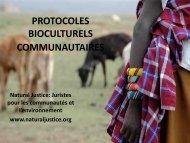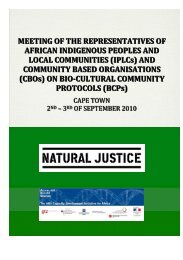The History of Farmers' Rights - Fridtjof Nansens Institutt
The History of Farmers' Rights - Fridtjof Nansens Institutt
The History of Farmers' Rights - Fridtjof Nansens Institutt
Create successful ePaper yourself
Turn your PDF publications into a flip-book with our unique Google optimized e-Paper software.
28 Regine Andersen<br />
right is compensation, and the fundamental obligation is the conservation<br />
<strong>of</strong> crop genetic diversity. For this purpose an international fund should be<br />
established to distribute compensation among the holders <strong>of</strong> farmers’<br />
rights, i.e. entities involved in the conservation and sustainable use <strong>of</strong><br />
traditional crop genetic diversity (pp. 259–261). Due to the nature <strong>of</strong> the<br />
utilization <strong>of</strong> crop genetic resources, the financial capabilities <strong>of</strong> countries<br />
in the South, and the development <strong>of</strong> intellectual property rights to genetic<br />
resources from the global genetic pool, compensation would basically<br />
have to be an international task (p. 282). <strong>The</strong>refore, realization <strong>of</strong> farmers’<br />
rights would have to take place at the international level and be enforced<br />
by states (p. 296). <strong>The</strong> international fund should distribute financial<br />
resources according to proposals submitted by rights holders, to be<br />
approved by a committee <strong>of</strong> internationally acclaimed experts (p. 308).<br />
<strong>The</strong> book concludes with a proposed agenda for farmers’ rights.<br />
***<br />
Correa, Carlos (2000): ‘Options for the Implementation <strong>of</strong> Farmers’<br />
<strong>Rights</strong> at the National Level’, South Centre: Working Paper 8,<br />
December 2000.<br />
This report is among the first to be written after the adoption <strong>of</strong> the text<br />
on farmers’ rights in 1999, which was to become the final formulation <strong>of</strong><br />
Article 9 in the International Treaty. After considering the origin <strong>of</strong> the<br />
concept <strong>of</strong> farmers’ rights, and how it has been incorporated in international<br />
regimes and national regulations, Correa explores in greater detail<br />
the rationale behind the concept. On this background, the relationship<br />
between farmers’ rights and intellectual property rights is explored,<br />
before various proposals for the contents and implementation <strong>of</strong> farmers’<br />
rights are discussed.<br />
Correa concludes that farmers’ rights may be seen as a ‘moral recognition<br />
to farmers’ past and present contributions to making agriculture sustainable’,<br />
as well as ‘concrete instruments to protect and promote traditional<br />
farming activities and communities’ culture and lifestyles’ (p. 41). <strong>The</strong><br />
possible scope and characteristics <strong>of</strong> the suggestions provided in the<br />
International Treaty on how governments can protect and promote farmers’<br />
rights need to be further developed, in order to provide more concrete<br />
guidelines to governments on how best to comply with their responsibilities<br />
in this field, he suggests. Work on realizing farmers’ rights will also<br />
require capacity building, training, transfer <strong>of</strong> technology and a fair reward<br />
for farmers’ contributions, among other things. Nevertheless, ‘there<br />
seem to be a gradual movement from the realm <strong>of</strong> ideas towards the design<br />
<strong>of</strong> such measures that can be realized in practice and which supports<br />
and promotes farmers’ activities in the conservation and improvement <strong>of</strong><br />
plant genetic resources for food and agriculture’ (pp. 41–42).<br />
Correa’s report contains an overview over national legislation and proposed<br />
legislation from several countries, with provisions pertaining to<br />
farmers’ rights. It further lists and discusses the possible content <strong>of</strong> and<br />
measures for farmers’ rights, and provides a detailed account <strong>of</strong> possible<br />
measures to establish national legislation on farmers’ rights according the




